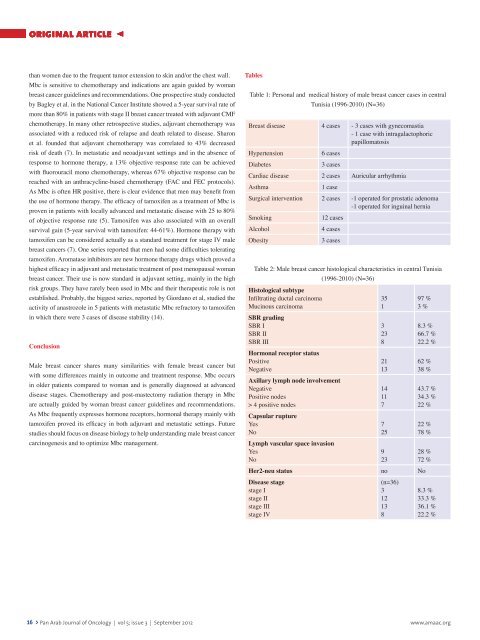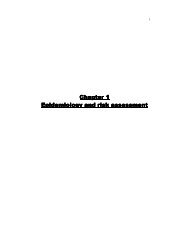Pan Arab Journal of Oncology - Arab Medical Association Against ...
Pan Arab Journal of Oncology - Arab Medical Association Against ...
Pan Arab Journal of Oncology - Arab Medical Association Against ...
Create successful ePaper yourself
Turn your PDF publications into a flip-book with our unique Google optimized e-Paper software.
original article <<br />
than women due to the frequent tumor extension to skin and/or the chest wall.<br />
Mbc is sensitive to chemotherapy and indications are again guided by woman<br />
breast cancer guidelines and recommendations. One prospective study conducted<br />
by Bagley et al. in the National Cancer Institute showed a 5-year survival rate <strong>of</strong><br />
more than 80% in patients with stage II breast cancer treated with adjuvant CMF<br />
chemotherapy. In many other retrospective studies, adjuvant chemotherapy was<br />
associated with a reduced risk <strong>of</strong> relapse and death related to disease. Sharon<br />
et al. founded that adjuvant chemotherapy was correlated to 43% decreased<br />
risk <strong>of</strong> death (7). In metastatic and neoadjuvant settings and in the absence <strong>of</strong><br />
response to hormone therapy, a 13% objective response rate can be achieved<br />
with fluorouracil mono chemotherapy, whereas 67% objective response can be<br />
reached with an anthracycline-based chemotherapy (FAC and FEC protocols).<br />
As Mbc is <strong>of</strong>ten HR positive, there is clear evidence that men may benefit from<br />
the use <strong>of</strong> hormone therapy. The efficacy <strong>of</strong> tamoxifen as a treatment <strong>of</strong> Mbc is<br />
proven in patients with locally advanced and metastatic disease with 25 to 80%<br />
<strong>of</strong> objective response rate (5). Tamoxifen was also associated with an overall<br />
survival gain (5-year survival with tamoxifen: 44-61%). Hormone therapy with<br />
tamoxifen can be considered actually as a standard treatment for stage IV male<br />
breast cancers (7). One series reported that men had some difficulties tolerating<br />
tamoxifen. Aromatase inhibitors are new hormone therapy drugs which proved a<br />
highest efficacy in adjuvant and metastatic treatment <strong>of</strong> post menopausal woman<br />
breast cancer. Their use is now standard in adjuvant setting, mainly in the high<br />
risk groups. They have rarely been used in Mbc and their therapeutic role is not<br />
established. Probably, the biggest series, reported by Giordano et al, studied the<br />
activity <strong>of</strong> anastrozole in 5 patients with metastatic Mbc refractory to tamoxifen<br />
in which there were 3 cases <strong>of</strong> disease stability (14).<br />
Conclusion<br />
Male breast cancer shares many similarities with female breast cancer but<br />
with some differences mainly in outcome and treatment response. Mbc occurs<br />
in older patients compared to woman and is generally diagnosed at advanced<br />
disease stages. Chemotherapy and post-mastectomy radiation therapy in Mbc<br />
are actually guided by woman breast cancer guidelines and recommendations.<br />
As Mbc frequently expresses hormone receptors, hormonal therapy mainly with<br />
tamoxifen proved its efficacy in both adjuvant and metastatic settings. Future<br />
studies should focus on disease biology to help understanding male breast cancer<br />
carcinogenesis and to optimize Mbc management.<br />
Tables<br />
Table 1: Personal and medical history <strong>of</strong> male breast cancer cases in central<br />
Tunisia (1996-2010) (N=36)<br />
Breast disease 4 cases - 3 cases with gynecomastia<br />
- 1 case with intragalactophoric<br />
papillomatosis<br />
Hypertension<br />
6 cases<br />
Diabetes<br />
3 cases<br />
Cardiac disease 2 cases Auricular arrhythmia<br />
Asthma<br />
1 case<br />
Surgical intervention 2 cases -1 operated for prostatic adenoma<br />
-1 operated for inguinal hernia<br />
Smoking<br />
12 cases<br />
Alcohol<br />
4 cases<br />
Obesity<br />
3 cases<br />
Table 2: Male breast cancer histological characteristics in central Tunisia<br />
(1996-2010) (N=36)<br />
Histological subtype<br />
Infiltrating ductal carcinoma<br />
Mucinous carcinoma<br />
SBR grading<br />
SBR I<br />
SBR II<br />
SBR III<br />
Hormonal receptor status<br />
Positive<br />
Negative<br />
Axillary lymph node involvement<br />
Negative<br />
Positive nodes<br />
> 4 positive nodes<br />
Capsular rupture<br />
Yes<br />
No<br />
Lymph vascular space invasion<br />
Yes<br />
No<br />
35<br />
1<br />
3<br />
23<br />
8<br />
21<br />
13<br />
14<br />
11<br />
7<br />
7<br />
25<br />
9<br />
23<br />
97 %<br />
3 %<br />
8.3 %<br />
66.7 %<br />
22.2 %<br />
62 %<br />
38 %<br />
43.7 %<br />
34.3 %<br />
22 %<br />
22 %<br />
78 %<br />
28 %<br />
72 %<br />
Her2-neu status no No<br />
Disease stage<br />
stage I<br />
stage II<br />
stage III<br />
stage IV<br />
(n=36)<br />
3<br />
12<br />
13<br />
8<br />
8.3 %<br />
33.3 %<br />
36.1 %<br />
22.2 %<br />
16 > <strong>Pan</strong> <strong>Arab</strong> <strong>Journal</strong> <strong>of</strong> <strong>Oncology</strong> | vol 5; issue 3 | September 2012<br />
www.amaac.org









